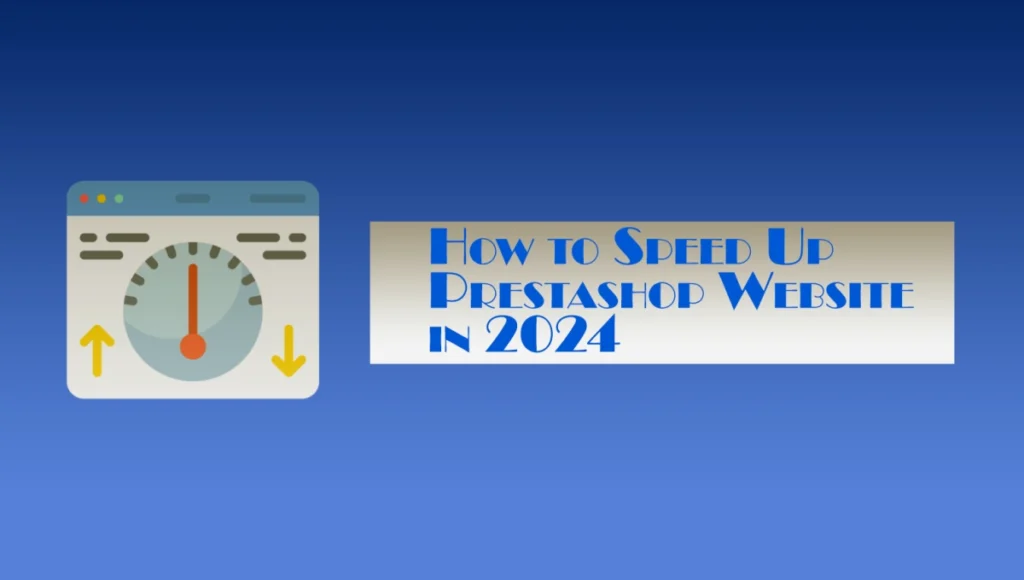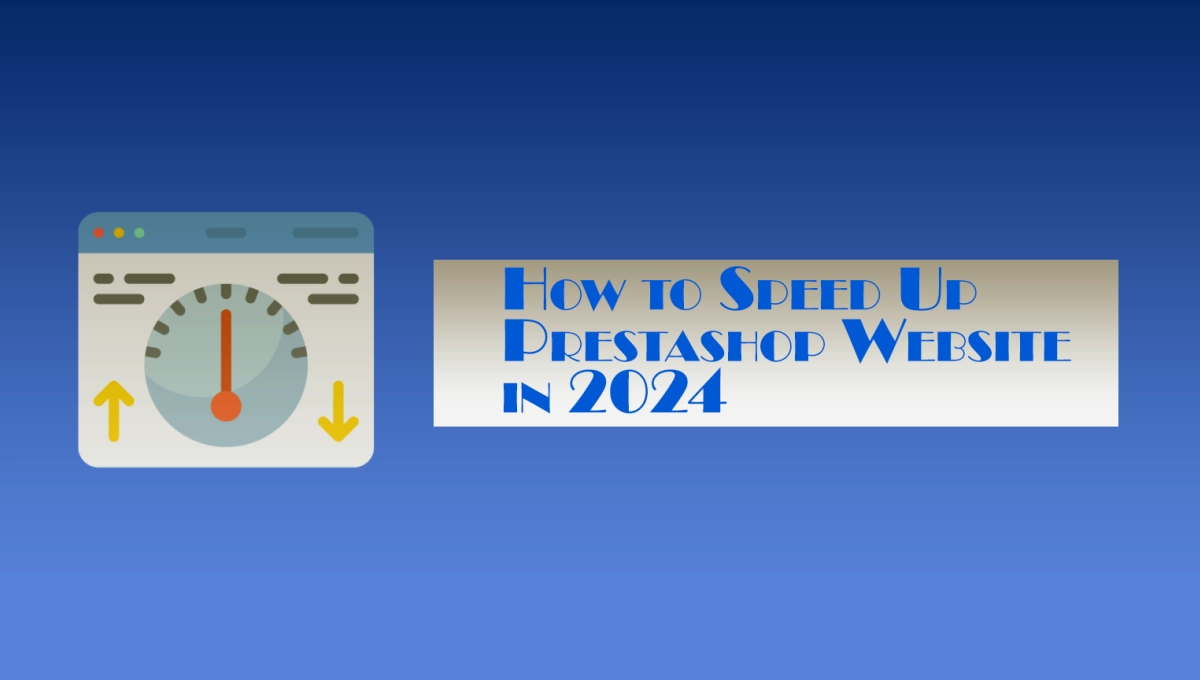In this lighting-fast-paced world of e-commerce, every second counts (also every click but we’ll get to that later). Did you know that a one-second delay in page load time can result in a 7% drop in conversions? 7%??? Ouch! YOU DON’T WANT THAT!

That’s why store owners optimize their Prestashop website for speed as it is no joke. Prestashop is a popular open-source e-commerce platform, which needs no introduction by the way. It caters to a vast user base and knows that keeping your store running smoothly is essential for happy customers and a thriving business.
Today we are gonna list the top tips and tricks to make your store highly functional for your beloved customers. This blog post is your one-stop guide to Prestashop speed optimization in 2024. We’ll delve into key strategies, tools, and best practices to make your store as fast as the speed of light.
Table of Contents
Understanding Website Speed and Why It Matters
Before we get into optimization techniques, let’s find out what website speed actually means. Here are some key points to keep in mind before you augment your journey:
- Page Load Time: This is the total time it takes for all the elements on your webpage to fully load. Aim for a page load time of under 3 seconds for an optimal user experience
- First Contentful Paint (FCP): This refers to the time it takes for the first content element (text, image, etc.) to appear on the screen. A faster FCP keeps visitors engaged.
- Largest Contentful Paint (LCP): This metric measures the time it takes for the main content of your webpage to render completely. Optimizing for LCP ensures a smooth user experience.
Website speed significantly impacts various aspects of your online store and your overall conversion rate.
- User Experience: A slow website frustrates visitors/customers and leads to higher bounce rates (bounce rate is when people leave your site without making any purchase). Studies by Impact Sciences show that 40% of visitors abandon a website that takes more than 3 seconds to load.
- Conversion Rates: Slower loading times translate to fewer sales. According to Neil Patel, a 1-second delay can reduce conversions by 7%.
- Search Engine Ranking (SEO): Google prioritizes fast-loading websites in search results. A speedy Prestashop store will rank higher organically, leading to more traffic.
Tools to Measure Website Speed
Now that we understand the importance of speed, let’s talk about measuring it. Here are some free and user-friendly tools to assess your Prestashop website’s performance:
- Google PageSpeed Insights: This tool by Google analyzes your website’s performance on mobile and desktop devices and offers specific recommendations for improvement (https://pagespeed.web.dev/).
- GTmetrix: This website speed-testing tool provides detailed reports with actionable insights to optimize your Prestashop store (https://gtmetrix.com/).
Optimizing Your Prestashop Website for a Higher Conversion Rate
We’ll explore various optimization strategies to speed up your Prestashop website, we’ll touch upon various topics and points.
1. Server-Side Optimization: Let’s get into the nitty gritty of server optimization.
- Choosing the Right Hosting Provider:
Your hosting provider lays the foundation for your website’s speed. Look for a provider with a robust infrastructure, including Solid-state Drives (SSDs) over traditional Hard Disk Drives (HDDs) for faster data transfer.
Plus, also ensure your hosting plan supports the latest PHP version for optimal performance with Prestashop. The cost of hosting varies depending on the plan you choose and the provider you go with.
Basic plans can start around $3-5 per month, while more feature-rich plans can range from $10-30 per month (be sure to factor in renewal rates and any additional fees).
- Prestashop Version Upgrade:
Regularly updating your Prestashop version (both core and modules) ensures you benefit from the latest performance improvements and security patches. The modules can be obtained from registered platforms with life time support as well.
The update process itself is free, though depending on the complexity of your store, you might need to factor in developer fees to ensure a smooth transition if customizations are involved.
- Database Optimization:
A clean and optimized database is essential for website speed. Regularly run database table optimization tasks within your Prestashop administration panel. Additionally, consider optimizing database queries to improve efficiency.
2. Content Delivery Network (CDN) Integration:
A CDN is a network of geographically distributed servers that store and deliver your website’s content (images, JavaScript, etc.) to users based on their location.
This significantly reduces load times, especially for visitors far from your primary server. The cost of a CDN varies depending on the provider, bandwidth usage, and features.
Basic plans can start around $10 per month, while enterprise-grade plans can reach hundreds or even thousands depending on your needs (be sure to check the free trial options offered by many CDN providers).
3. Prestashop-Specific Optimization Strategies:
- Enable Caching: Caching stores frequently accessed data, reducing the load on your server and speeding up page load times. Prestashop offers built-in caching options, including Smarty cache and page cache. Utilize these features to their full potential.
- Combine, Compress, and Cache (CCC): This functionality in Prestashop combines, compresses, and caches static files like CSS, JavaScript, and images. This reduces the number of HTTP requests and minimizes file size, leading to faster loading times. Enable and configure CCC in your Prestashop back office for optimal results.
- Image Optimization: High-quality images are essential for product presentation, but large unoptimized images can significantly slow down your website. Utilize tools like TinyPNG or ShortPixel to compress images without sacrificing quality. These tools offer both free and paid plans, with free plans typically having limitations on the number of images you can optimize per month. Paid plans start around $5-10 per month depending on features and image volume.
- Module Management: Unused Prestashop modules can drain resources and slow down your website. Regularly review your installed modules and disable or uninstall any that are no longer required. Additionally, keep your active modules updated to benefit from performance improvements.
4. Additional Tips and Tools:
- Leverage Browser Caching: Configure your server to leverage browser caching for static files like images and CSS. This reduces the need to download these files repeatedly for returning visitors.
- Minify HTML, CSS, and JavaScript Files: Minification removes unnecessary characters and formatting from code files, resulting in smaller file sizes and faster loading times. Several free online tools can help you with minification.
- Utilize Lazy Loading for Images: This technique delays the loading of images below the fold (not immediately visible on the screen) until the user scrolls down. This prioritizes the loading of above-the-fold content, leading to a faster-perceived page load time.
- Regularly Monitor Website Performance: Use website speed testing tools like those mentioned earlier to track your progress and identify any recurring issues.
5. Conclusion:
Website speed optimization is an ongoing process, not a one-time fix. You have to revisit these steps every now and then to improve your website’s functionality and provide a better user experience to your customers. You have to keep implementing the strategies outlined above and continuously monitoring your Prestashop website’s performance. Only then you can ensure a lightning-fast experience for your visitors. This will lead to higher conversion rates, better SEO ranking, and a thriving online store and honestly that’s all you want.
Real-Life and Real-Time Example
Let’s look at a real-world example to gain a better understanding of the phenomenon. A clothing store with top-notch quality and reputation, built on Prestashop but with poor speed optimization, was experiencing significantly slow loading times.
That resulted in high bounce rates and lost sales which led to the company losing out on huge revenues. After implementing a combination of server-side optimization (upgrading the hosting plan, updating Prestashop), utilizing a CDN, enabling caching and CCC, and optimizing images, the store saw a 40% reduction in page load time. This led to a 20% increase in conversion rates and a significant boost in overall sales.
What does that show us? That applying such measures has real-time and quick impacts. Your store is your first impression on the potential customer. The rest comes later. The quality of your products and services comes late into the picture. But your store’s functionality is what that stands between customer and their experiences of your product quality. Never compromise on that. Remember, a speedy Prestashop website is a happy customer magnet and it ensures you the success that you promised yourself when you took your first step to store building!
Author bio: Joseph Chain is a Professional Digital Marketer having experience of more than 5 years in the field. Currently working in a PrestaShop development company, FME Modules and striving to deliver engaging content across diverse industries.
Don’t forget to support us by following us on Google News or Returning to the home page TopicsTalk
Join Telegram and WhatsApp for More updates
Follow us on social media




